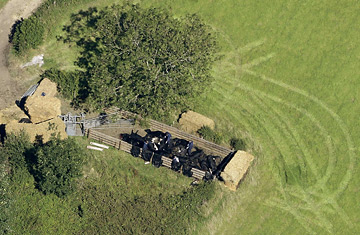
Officials stand amongst slaughtered cows at a farm near Guildford in a bid to contain the latest outbreak of the highly infectious foot-and-mouth disease.
In late autumn, 1967, British government officials huddled in a small map room in London. They put a single colored pin on the town of Nantmawr, in Western England, where a vet had uncovered three cases of foot-and-mouth disease (FMD) in pigs. Then they waited. Within days, the colored pinheads began spreading over the country like an ulcerated rash.
More than 400 farms were affected in less than a week in the Foot-and-Mouth Outbreak of 1967 — the worst outbreak of the disease in Britain until the infamous 2001 epidemic. The virus that caused the outbreak — later termed 01 BFS67 — was isolated, and a sample sent to a secure research facility in Pirbright, Surrey, for future work on vaccines.
Now 01 BFS67 is back — on a farm less than 5 miles (8 km) from the Pirbright research laboratory dedicated to eliminating it. Official confirmation is not expected until tomorrow, but biosecurity experts suspect that the lab — home to a government research center and a company that makes FMD vaccines — was the source of the outbreak.
The news raised hopes that the disease, which causes blistering and fever in pigs, cattle, sheep, goats and deer, was not spread by other animals and could therefore be easily contained. But it has also put the safety of bioresearch facilities such as Pirbright under scrutiny.
Biosecurity officials spent Monday scouring the high-security site, which is shared by the government's Institute for Animal Health and a private pharmaceutical company, Merial Animal Health, the British arm of U.S.-based Merial Ltd. Reports in British media said investigators were focusing on the Merial facility because it has recently done research on the 01 BFS67 strain, in an effort to determine whether human error or a breach in biosecurity — such as a faulty ventilation system — could be to blame.
David Biland, managing director at Merial, said in a statement that the company "operates to the very highest international standards and we have complete confidence in the integrity of our operation here. It is still too early in this investigation for anyone to determine the cause of the outbreak."
That is certainly true, and in a 2002 government review, it was the Institute for Animal Health, not Merial, which drew criticism for the standard of some of its laboratories. According to the BBC, the review said standards at some institute facilities were "not commensurate with what might be expected for work with infectious diseases." The report also raised questions about the loss of key skills at the Pirbright laboratory as senior personnel left and were not replaced.
Earlier this year, the head of the laboratory, Professor Martin Shirley, told a Parliament select committee he was trying to run a Rolls Royce service, but was being "funded at the level of a Ford Cortina." (On Monday, he told the BBC that he stood by his comments but refused to comment any further.)
The challenge of safeguarding research facilities is not just Britain's. In 2003, the U.S. General Accounting Office (now called the Government Accountability Office) found serious flaws in the security of the 50-year-old Plum Island Animal Disease Center off eastern Long Island, New York — the only facility in America cleared to research FMD. Two years later, the U.S. Department of Homeland Security said the facility had become outmoded and "increasingly costly to maintain." Last year, the department said it was considering locations for a new, $450 million disease lab.
Leading British Microbiologist Hugh Pennington said both Pirbright and Plum Island face similar problems. "Both are housed in old buildings, and the aging infrastructure presents challenges. The biosecurity at both centers is known to be very good, but that's not to say it's perfect, and with research into such dangerous diseases you really need to be state-of-the-art," he told TIME.
As investigations to confirm the source of the outbreak continued, the European Commission said Monday it had banned all live animal exports from Britain, as well as meat and dairy products from the infected area. Further restrictions may come into force on Wednesday, raising concerns about the impact to British agriculture. The FMD outbreak six years ago devastated British farming and hit tourism, costing the economy an estimated $17 billion. But with focus on a government laboratory and vaccination firm, there is a deeper concern among British farmers, and its citizens: can they trust the very people employed to protect them?
